Frequently Asked Questions
What is osteopathy, and how does it differ from other therapies?
Osteopathy is a holistic, non-invasive therapy that focuses on the body’s musculoskeletal system, including bones, muscles, ligaments, and connective tissues. Unlike other therapies, osteopathy aims to treat the whole body rather than just the symptoms, addressing the root causes of pain and dysfunction to promote long-term health and well-being.
What conditions can osteopathy help with?
Osteopathy can effectively treat a wide range of conditions, including chronic pain, joint and disc issues, sports injuries, headaches, migraines, postural problems, and nerve pain like sciatica. It is also beneficial for managing musculoskeletal disorders such as arthritis and tendonitis.
Is osteopathy safe?
Yes, osteopathy is a safe and gentle treatment. Osteopathic techniques are designed to be non-invasive and work in harmony with the body’s natural healing processes. Your practitioner will ensure that all treatments are appropriate for your specific needs and conditions.
What can I expect during an osteopathy session?
During your first session, your osteopath will take a detailed medical history and perform a physical examination to understand your condition. Treatment typically involves hands-on techniques such as soft tissue stretching, joint mobilization, and gentle manipulation to relieve pain and restore function. Follow-up sessions will be tailored to your progress and specific health goals.
How many sessions will I need?
The number of sessions required varies depending on the nature and severity of your condition. Some patients experience significant relief after just one or two sessions, while others with more chronic issues may need ongoing treatment. Your osteopath will work with you to create a personalized treatment plan.
Is osteopathy covered by insurance?
Osteopathy services are not covered by OHIP, but they are often covered by extended health insurance plans. Coverage varies by provider, so it’s best to check with your insurance company to understand your benefits.
Do I need a referral to see an osteopath?
No, you do not need a referral to book an appointment with an osteopath. However, some insurance plans may require a referral for coverage, so it’s a good idea to check with your provider.
What should I wear to my osteopathy appointment?
It’s best to wear comfortable, loose-fitting clothing to your appointment. This allows your osteopath to easily access the areas of your body that need treatment while keeping you comfortable throughout the session.

